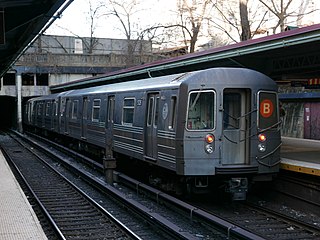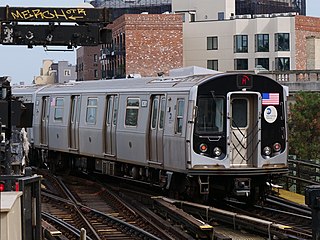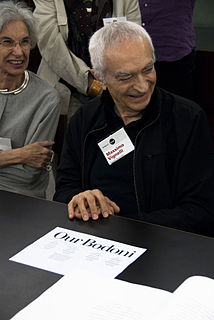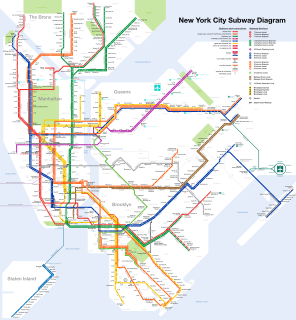
The New York City Subway is a rapid transit system owned by the government of New York City and leased to the New York City Transit Authority, an affiliate agency of the state-run Metropolitan Transportation Authority (MTA). Opened on October 27, 1904, the New York City Subway is one of the world's oldest public transit systems, one of the most-used, and the one with the most stations, with 472 stations in operation. Stations are located throughout the boroughs of Manhattan, Brooklyn, Queens, and the Bronx.

The 4 Lexington Avenue Express is a rapid transit service in the A Division of the New York City Subway. Its route emblem, or "bullet", is colored forest green since it uses the IRT Lexington Avenue Line in Manhattan.

The 5 Lexington Avenue Express is a rapid transit service in the A Division of the New York City Subway. Its route emblem, or "bullet", is colored apple green since it uses the IRT Lexington Avenue Line in Manhattan.

The A Eighth Avenue Express is a rapid transit service in the B Division of the New York City Subway. Its route emblem, or "bullet", is colored blue since it uses the IND Eighth Avenue Line in Manhattan.

The E Eighth Avenue Local is a rapid transit service in the B Division of the New York City Subway. Its route emblem, or "bullet", is blue since it uses the IND Eighth Avenue Line in Manhattan.

The Astor Place station, also called Astor Place–Cooper Union on signs, is a local station on the IRT Lexington Avenue Line of the New York City Subway. Located at Fourth Avenue, Cooper Square, and Astor Place between the East Village and NoHo, it is served by 6 trains at all times, <6> trains during weekdays in the peak direction, and 4 trains during late night hours.

The W Broadway Local is a rapid transit service of the New York City Subway's B Division. Its route emblem, or "bullet", is colored yellow since it uses the BMT Broadway Line in Manhattan.

The B Sixth Avenue Express is a rapid transit service in the B Division of the New York City Subway. Its route emblem, or "bullet", is colored orange, since it uses the IND Sixth Avenue Line in Manhattan.

Three services in the New York City Subway are designated as a dark gray S (shuttle) service. These services operate as full-time or almost full-time shuttles. In addition, three services run as shuttles during late night hours but retain their regular service designations.

New York City Subway nomenclature is the terminology used in the New York City Subway system as derived from railroading practice, historical origins of the system, and engineering, publicity, and legal usage. Important terms include lines, or individual sections of subway, like the BMT Brighton Line; services, like the B, which is a single train route along several lines; and stations, such as Coney Island–Stillwell Avenue, which connects multiple lines and services.
The BMT Nassau Street Line is a rapid transit line of the B Division of the New York City Subway system in Manhattan. It is a continuation of the BMT Jamaica Line in Brooklyn after crossing the Williamsburg Bridge into Manhattan; it continues to a junction with the BMT Broadway Line just before the Montague Street Tunnel. Afterwards, the line reenters Brooklyn. Although the tracks continue past Broad Street, there has been no regular service past that station since June 25, 2010. While the line is officially recognized as the Nassau Street Line, it only serves one station on Nassau Street: Fulton Street.

The New York City Subway is a rapid transit system that serves four of the five boroughs of New York City, New York: the Bronx, Brooklyn, Manhattan, and Queens. Its operator is the New York City Transit Authority (NYCTA), which is controlled by the Metropolitan Transportation Authority (MTA) of New York. In 2016, an average of 5.66 million passengers used the system daily, making it the busiest rapid transit system in the United States and the seventh busiest in the world.

The M Queens Boulevard/Sixth Avenue Local is a rapid transit service in the B Division of the New York City Subway. Its route emblem, or "bullet", is colored orange since it uses the IND Sixth Avenue Line in Manhattan.

Massimo Vignelli was an Italian designer who worked in a number of areas including packaging, houseware, furniture, public signage, and showroom design. He was the co-founder of Vignelli Associates, with his wife, Lella. His motto was, "If you can design one thing, you can design everything," which the broad range of his work reflects.

The Fifth Avenue/53rd Street station is a station on the IND Queens Boulevard Line of the New York City Subway. Located at the intersection of Fifth Avenue and 53rd Street in Manhattan, it is served by the E train at all times and the M train weekdays except late nights.

The Canal Street station is a local station on the IRT Broadway–Seventh Avenue Line of the New York City Subway, located in Lower Manhattan at the intersection of Canal and Varick Streets. It is served by the 1 train at all times and by the 2 train during late nights.
Michael Hertz Associates (MHA) is a New York City graphic design firm, best known for its 1979 design of the New York City Subway map and the station and subway car signage systems that the map engendered. The 1979 map, with some modifications, remains in use today. The firm specializes in maps and environmental graphics for mass transit systems.

Lella Vignelli was an Italian designer who was the co-founder of Vignelli Associates. She had "a lifelong collaborative working relationship" with her husband, Massimo Vignelli. She was known to be the business arm of Vignelli Associates and she played a key role in the success of the design firm.

Many transit maps for the New York City Subway have been designed since the subway's inception in 1904. Because the subway was originally built by three separate companies, an official map for all subway lines was not created until 1940, when the three companies were consolidated under a single operator. Since then, the official map has undergone several complete revisions, with intervening periods of comparative stability.
Vignelli Associates was a design firm co-founded and run by Massimo and Lella Vignelli in New York City, from 1971 until 2014. They worked firmly within the modernist tradition, stressing simplicity by using basic geometric shapes and a limited range of typefaces. Their design work, encompassing graphic design, branding and corporate identity, architecture and interiors, and industrial design is considered among the most influential of the 20th century.
















